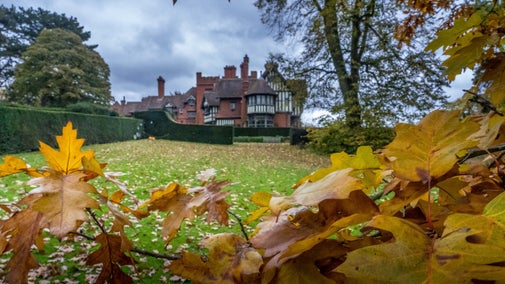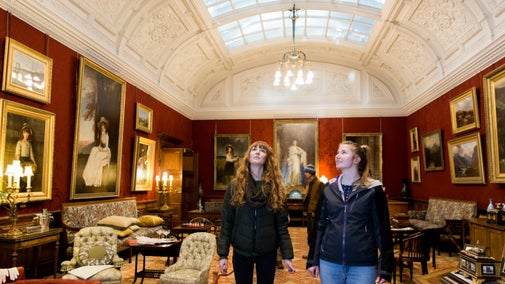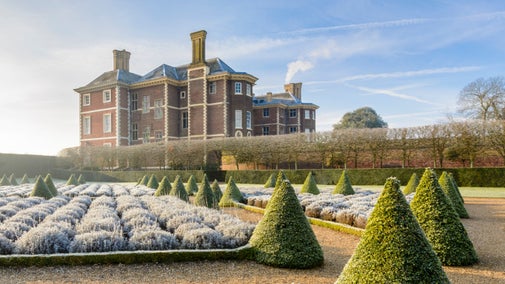
Wightwick's collections
Explore the objects and works of art we care for at Wightwick Manor on the National Trust Collections website.

When Theodore Mander commissioned the building of a new manor on Wightwick Bank in 1887 he started the Mander family's love for Victorian art and design which would unfold over a century of collecting and preservation. HIs untimely death in 1900 left the care and development of the new home to his son, Geoffrey. His story is one of art and design, industry and politics, told through the house he saved and lived in.
Before you enter the Manor, you will be asked to leave any rucksacks or large bags (bigger than A4 size) in your car, or placed in one of our lockers (available on a first-come, first-served basis). In addition, large back-carrying baby carriers are not permitted in the Manor; front-style carriers are ok or we have hip carriers available to borrow. We also ask that pushchairs and mobility scooters are left outside the Manor, only electric wheelchairs are permitted. Manual wheelchairs are available to borrow upon request. Thank you for your support in caring for our house and collection.
Although the art and design collections stand out, most of the items at Wightwick are deeply personal. The Mander family left an archive full of letters and photos covering their whole lives.
Geoffrey Mander was very clear the house should remain a home and not become an art gallery, and he said as much in Parliament.
The artwork is therefore shown in a domestic setting. This theme is maintained by not placing labels next to items. Instead, information can be found in the catalogues provided in rooms.
When it was built the house was fitted with electric lighting, which was cutting edge for 1887.
However, by today's standards the rooms are quite dark and, on a cloudy day, areas can feel a bit gloomy, so give your eyes a chance to adjust.
The house was built with central heating, and many of the original radiators still work.
However, the house is now heated more for the care of the collection than to stay warm. The heating helps combat high humidity levels, which can lead to mould growth.
It often surprises visitors that William Morris never came to the house, nor did his company formally design for it.
Instead, all the wallpapers, fabric wall coverings and soft furnishings were bought through the Morris & Co shop or catalogue.
Unlike the artwork, Morris & Co designs were included in the 1887 and 1893 buildings.
However, they were much enhanced after the 1937 saving of the property, when Sir Geoffrey expanded the Manor's Morris collection (or 'Morrisania' as the National Trust's Historic Buildings secretary called it).
This included sketches for Morris designs, as well as large items of furnishings, such as carpets and curtains.
Morris loved traditional dyes and colours, however they don't stand the test of time or exposure to light particularly well. Light levels are managed carefully in certain rooms. Unlike a watercolour or photograph you can't move wallpaper to a darker corner.
The house still has the feeling of being lived in. Paintings and furniture are regularly moved around just as the family would have done. Paintings are regularly loaned to other museums for exhibition.
If you want to sit down and take a moment to savour the space, all you have to do is look out for a cushion with a cat on it - a tribute to Lady Mander's love of cats.
There are toys to play with in the nursery and you can try out the full-size billiards table, allowing you to pretend you're an Edwardian gentleman playing in opulent surroundings.
The old range is still in use and lit on cold days, giving the Victorian Kitchen a special atmosphere with the smell of burning coal.

Wightwick is a house and collection which has something to appeal to all visitors.
For those who love Pre-Raphaelite art or Morris designs and want to understand where an item came from, feel free to ask our volunteer room guides any questions during your visit.
Alternatively, you can find our detailed guidebook for sale in the Old Manor shop.
When Edward Ould designed the house, he was trying to make it feel quirky and give the impression it was a much older house which had evolved over time.
This means there are some short flights of steps in the Manor, but most of the ground floor with the principal collection is accessible, and if you can't make the stairs to the bedrooms there is a photo guide you can leaf through.
Remarkably for a house now so associated with this art movement, Wightwick had no Pre-Raphaelite art prior to 1937.
Once the house was known to be in our care, Sir Geoffrey and Lady Mander started to buy art to put on display for their visitors.
The first was a portrait of Jane Morris by Rossetti and Madox Brown, which the Manders donated to the Trust.
Over time a unique collection developed, with some major pieces supplied by the National Trust, and small works and sketches either purchased or given to the National Trust.
The collection now boasts over 70 works by D.G Rossetti, 50 by Edward Burne-Jones, 23 by Evelyn De Morgan's and 20 by Millais.
There are also works by the often overlooked Pre-Raphaelites; Lizzy Siddal, Lucy Maddox Brown and Simeon Solomon.

Explore the objects and works of art we care for at Wightwick Manor on the National Trust Collections website.
After more than 125 years, Wightwick Manor's timber frame was showing signs of deterioration. Thanks to a grant from Arts Council England, a 3-year repair project started in 2023.
Visit the De Morgan Gallery, a partnership with the De Morgan Foundation. ‘Look Beneath the Lustre’ looks at how Evelyn and William De Morgan were inspired to create art.

Meet the original influencers; the romantic rulebreakers working in the mid to late 1800s and the effect their work and ideas had on the Manders’ décor choices at Wightwick.

The garden at Wightwick is the perfect place for a walk after enjoying the delights of the house. Designed by Thomas Mawson, today it has something to see no matter what the season.

Find out more about booking your group for a visit to Wightwick and the information you need to help you plan your trip.

The art and heritage collections we care for rival the world’s greatest museums. Learn more about the collection of paintings, decorative art, costume, books, household and other objects at historic places.

Historic houses and buildings are full of stories, art and collections. Learn more about their past and plan your next visit.

Discover the historic houses and buildings of Shropshire and Staffordshire, encompassing caves dwellings, a timber-framed manor and the house that saved a King.
